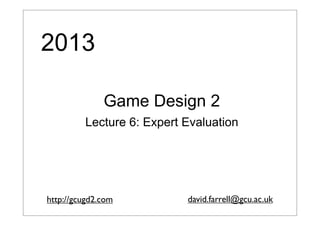
Game design 2 (2013): Lecture 10 - Expert Evaluation Methods for Game UI
- 1. 2013 Game Design 2 Lecture 6: Expert Evaluation http://gcugd2.com david.farrell@gcu.ac.uk
- 2. Expert Evaluations & Design / Usability Heuristics Will look at: • Need for alternatives to user evaluation • Methods of evaluating without end users (using expert evaluators) • Some heuristics / guidelines offered by experts
- 3. End User Evaluations • End-user evaluations can be expensive – The methods are very time consuming – Users may not be willing – To get truly ‘fresh’ eyes, so called “kleenex” testing requires different players each time • Concerns about leaks – Few external play testers at early stages – Friends & family play testers may be too kind
- 4. Expert Evaluations • As an alternative to some user testing, expert evaluators / testers can be used • Falconer details 10 inspection methods, we will look at two: – Cognitive Walkthrough – Heuristic Evaluation
- 5. Cognitive Walkthrough • In this approach experts imitate users – Relatively quick and cheap – Expert needs to be skilled in the system or to be familiar with the prototype / design. • Two phase process – gathering inputs – doing the walkthrough
- 6. Cog Walk Phase 1 • Two phase process. • Phase 1: Gathering Inputs • • • • A description of users (e.g. level of experience) A description of system (or an operational system) A description of the task to be carried out A list of the actions required to complete the task – step by step!
- 7. Cog Walk: Phase 2 • Phase 2: Walkthrough – take each of the actions in the list – and ask the following questions: • Is the goal clear at this stage? • Is the appropriate action obvious? • Is it clear that the appropriate action leads to the goal? • What problems (or potential problems) are there in performing the action? • Essential that the expert tries to think like the end user and not like themselves.
- 8. Cognitive Walkthrough • For each step of the process, you ask those questions and you write a ‘success story’ - is it likely that the user will successfully achieve this step. If not, why not?
- 9. Consider Dwarf Fortress • A scenario: – Task is to make beds for your dwarves – what are the actions? • • • • • • open designate menu, choose ‘chop down trees’ select trees construct carpenter’s workshop open workshop menu, ‘add’ beds look at dwarves - make sure there exists a dwarf with ‘wood chopping’ and another with ‘carpentry’ • (even these actions are not low level enough - I’ve abbreviated for ease of presentation)
- 10. Heuristic Evaluation • Involves assessing how closely an interface or system conforms to a predefined set of guidelines or heuristics. • Examples: – Nielsen’s usability heuristics – Schneiderman’s eight golden rules – Norman’s seven principles
- 11. Nielsen’s Usability Heuristics • Give feedback – keep users informed about what is happening • Speak the user’s language – dialogs should be expressed clearly using terms familiar to the user • User control and freedom – clearly marked exits and undo/redo • • Consistency and standards Prevent errors – even better than having good error messages
- 12. Nielsen’s Usability Heuristics • Minimise memory load – • Shortcuts – • don’t have irrelevant or rarely needed information Good error messages – • accelerators (unseen by novices) speed up interactions for experts Aesthetic and minimalist design – • recognition rather than recall should indicate the problem and explain how to recover Help and documentation – should be concise and easy to search
- 13. Norman’s 7 Principles 1: Use both knowledge in the world and knowledge in the head. 2: Simplify the structure of tasks. 3: Make things visible. 4: Get the mappings right. 5: Exploit the power of constraints. 6: Design for error. 7: When all else fails, standardise.
- 14. Schneiderman’s heuristics (8 Golden Rules) 1. 2. 3. 4. 5. 6. 7. 8. Strive for consistency Enable frequent users to use shortcuts Offer informative feedback Design dialogues to yield closure Offer error prevention & simple error handling Permit easy reversal of actions Support internal locus of control Reduce short-term memory load (Faulkner Chapter 7)
- 15. How Many Evaluators? Different people find different problems. http://bit.ly/heuristichowto
